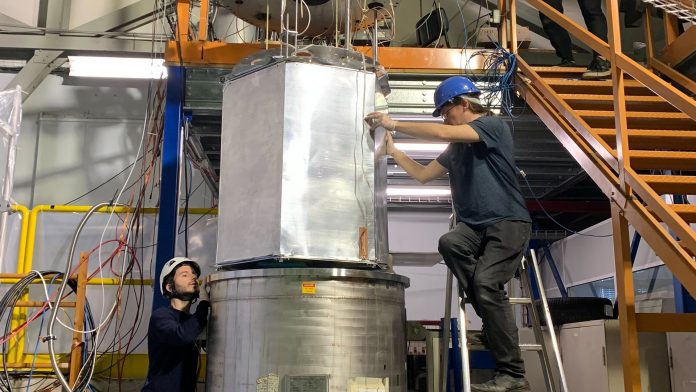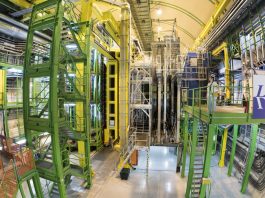Professor Marcin Kuźniak, DarkWave Coordinator at AstroCeNT, explains how novel technologies are used to detect dark matter particles and neutrinos.
Our Universe is full of mysteries waiting to be solved. One of the greatest riddles of modern physics is the nature of dark matter particles and neutrinos. Despite the fact that they make up a significant part of the Universe, we still know little about these elusive particles. However, with the help of groundbreaking technologies, we are getting closer to understanding their properties, so that we can use them as a new window on the hidden Universe. This quest for knowledge not only deepens our understanding of the Universe but has the potential to revolutionise our way of life.
Here, we will look at how DarkWave, a project funded by the European Commission (Grant No 952480) and implemented by a consortium of five research institutes – AstroCeNT/ Nicolaus Copernicus Astronomical Center (a recently established in Poland Centre of Excellence in astroparticle physics), Laboratoire Astroparticule & Cosmologie/CNRS, Istituto Nazionale di Fisica Nucleare and Gran Sasso Science Institute, Technical University of Münich – contributes to this scientific endeavour.
Dark or transparent matter?
In the current standard model of cosmology, dark matter particles make up 27% of the Universe and are driving how the observed galaxy-scale and larger structures form, evolve and move. Normal matter contributes 5%, out of which neutrinos contribute 0.3%. The remainder is filled by dark energy, which affects the Universe’s expansion rate.
Unlike ordinary matter, neutrinos and dark matter do not respond to the electromagnetic force. They are not even just dark but utterly transparent – they do not absorb, reflect, or scatter photons. This makes it difficult for them to have any effect on normal matter at all: a large number of cosmic neutrinos and dark matter particles constantly stream through Earth without a noticeable effect. Nevertheless, both the standard model of cosmology and the Standard Model of particle physics only make sense if there is a dark matter particle, and the properties of neutrinos and dark matter are key to our understanding of the evolution of the Universe. Hence, we build detectors to observe them.
Neutrino interactions with matter induce detectable electric charges, but they are so rare that large numbers of target atoms must be observed to get even a small number of interactions. For dark matter, the situation is even more complicated: we do not yet know what kind of particle dark matter even is.
Some particle physics theories predict a weakly interacting massive particle (WIMP) that would be able to scatter on atomic nuclei, imparting some kinetic energy to them. Tonnes of target atoms must be observed for this sudden extra kinetic energy release over years of time. Such experiments are performed in deep underground laboratories, such as INFN Laboratori Nazionali del Gran Sasso (LNGS) in Italy, where DarkSide-20k, the next most sensitive dark matter detector, is being built. Kilometres of rock are needed to shield natural cosmic radiation, which would otherwise completely drown out the sought exotic signals.
Seeing the light
Detecting these invisible dark matter particles comes down to sensing the photons which they indirectly induce in matter. One of the best ways to be sensitive to WIMP and neutrino interactions is with a scintillator – a material that emits flashes of light. This light travels through the large detector volume and is detected with photo sensors arranged around the target volume. Liquid argon is an excellent scintillator, but sensing its emission is another challenge. Most commercial sensors are not sensitive to the far UV light it emits; it must be converted to visible light using so-called wavelength shifter (WLS) materials. One of the challenges for the next generation of dark matter and neutrino detectors is scaling up the WLS and photo sensor technologies to 100m2 and more. The DarkWave project addresses key aspects of this challenge: generation, collection, and detection of light.
To maximise the amount of light generated, specially purified liquid argon will be used. Prior to filling the DarkSide-20k detector, argon will be refined in the recently opened Aria facility in Sardinia where a 350m-tall cryogenic distillation tower is being constructed. Every single photon is important, so a combination of highly-efficient WLS and reflector materials are used to line the detector walls. The veto detector, which surrounds the main WIMP detector and suppresses natural radiation backgrounds, has a 200m2 surface area. After extensive testing and prototyping led by AstroCeNT, and measurements in liquid argon at Gran Sasso, University of Zürich, and CERN, a common plastic, polyethylene naphthalate (PEN), normally used to make things such as beer bottles, was selected as the WLS for the veto. The efficiency of PEN is lower than that of purpose-made materials, but it makes up for it by its low cost and existing industrial large-area manufacturing facilities.
Then 26m2 of photosensors are needed, for which novel silicon photomultiplier modules will be used. The DarkSide-20k collaboration has pioneered this technology for liquid argon, and developed 20cm x 20cm photo detector units (PDU), which replace traditional large glass photomultiplier tubes, have higher efficiency, and contribute less backgrounds. Participating in the mass production of PDUs at LNGS, as well as their cryogenic testing at AstroCeNT, are part of our project. This is complemented by development of advanced simulation, and analysis tools for the PDU data, led by APC. Further research for even more sensitive future detectors is still in progress. New enhanced WLS, with possible applications also in photovoltaics, are studied at AstroCeNT and TUM. Digital silicon photomultipliers (SiPMs) are developed at INFN Torino. They also find use in positron emission tomography (PET) to diagnose cancer, as in the 3Dπ project where DarkWave members are active.
Listening to the waves of the Universe
Another synergy exploited by DarkWave involves gravitational wave observation in very sensitive detectors, such as LIGO and its European counterpart, Virgo. Extremely small fluctuations in spacetime due to the passing of a gravitational wave cause a distance of several kilometres to expand or contract by less than the diameter of a proton. Such tiny contractions can be detected as long as external noise and vibrations are minimised, monitored, and properly subtracted from the data. Newtonian noise, caused by the movement of masses in the vicinity of the detector, may hamper future improvements in sensitivity.
Networks of very sensitive seismic and infrasound sensors, successfully developed and prototyped by AstroCeNT, have been installed in Virgo and are now used to measure the seismic and infrasound noise and to estimate the Newtonian noise. They are also used to characterise the candidate locations for the Einstein Telescope – the next-generation observatory. Although not directly used in dark matter and neutrino detectors, they still play a role in helping to monitor the background noise and detector performance. In the spring of 2023, a large set of seismic sensors were installed in the Gran Sasso underground laboratory to survey seismic noise at the DarkSide-20k location.
Unprecedented sensitivities for the detection of ultra-faint signals from the hidden Universe require substantial R&D for the scale-up of detectors and new disruptive technologies, which also benefit society. This is particularly true in the areas of light collection and detection, where DarkWave has successfully fostered co-operation and bridged multiple experimental collaborations working on dark matter particles, neutrinos, and gravitational waves.
Please note, this article will also appear in the fourteenth edition of our quarterly publication.





